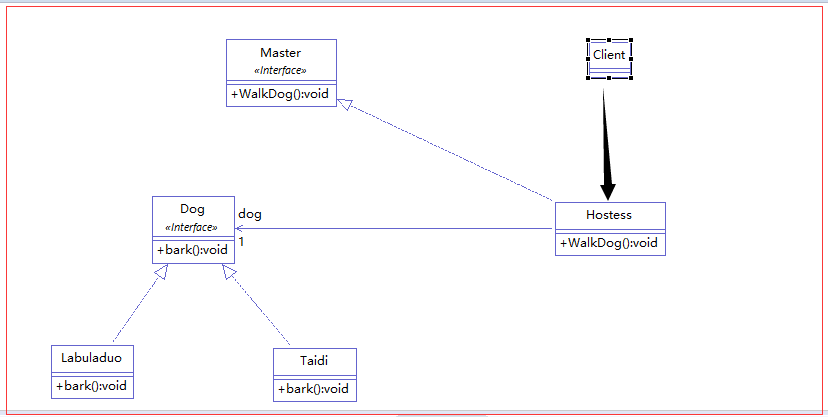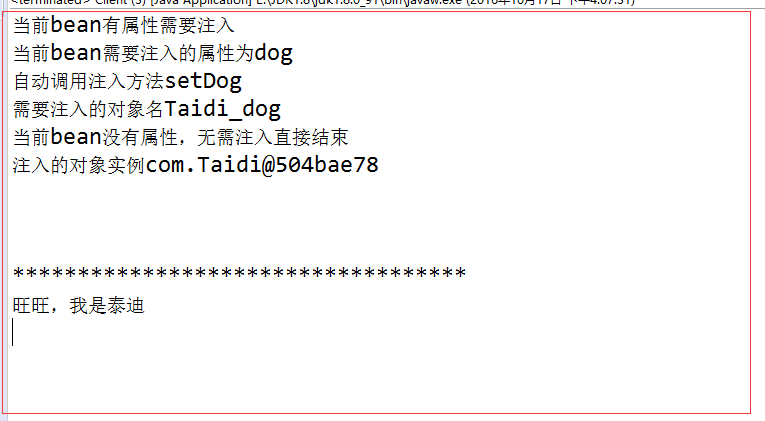自己动手编写spring IOC源码
前言:对于spring IOC概念不是很了解的朋友可以阅读我上一篇博客——轻松理解spring IOC(这两篇博客也是由于我的个人原因导致现在才发布,惭愧啊)。通过这篇博客的理解之后,相信大家会对spring的IOC概念会有进一步的理解。接下来我先预览一下本例中java的类图关系。
解析:我们有一个Master接口,接口中定义了一个WalkDog()遛狗的方法,Hostess是对这个接口的具体实现。然后我们有一个Dog接口,接口中有一个bark()方法,Labuladuo和Taidi是对其的实现。最后我们的程序入口Client类调用Hostess对象的WalkDog方法。
需求:Hostess对象遛狗需要一个狗对象,目前我们的类中有两个符合需求的对象,我们只要在配置文件中进行相关配置便可以指定我们的Hostess对象调用的是哪一个具体的Dog对象。
public static void main(String[] args) {
ApplicationContext context = new ClassPathXmlApplicationContext("applicationContext.xml");
Master master = (Master)context.getBean("hostess");
System.out.println();
System.out.println();
System.out.println();
System.out.println("***********************************");
master.WalkDog();
}
解析:从main方法的前两句原spring的代码中我们可以猜想,spring框架中一定是定义了ApplicationContext这个接口,并且接口中定义了一个getBean()的方法,而ClassPathXmlApplicationContext类肯定是对其的实现。既然是我们自己动手写spring框架,我们把这个接口和类实现了也就可以了。
接口 ApplicationContext
public interface ApplicationContext {
public Object getBean(String beanid);
}
实现类 ClassPathXmlApplicationContext
package com; import java.io.File;
import java.lang.reflect.Method; import org.dom4j.Document;
import org.dom4j.DocumentException;
import org.dom4j.Element;
import org.dom4j.Node;
import org.dom4j.io.SAXReader; public class ClassPathXmlApplicationContext implements ApplicationContext { private String fileName; public ClassPathXmlApplicationContext(String fileName){
this.fileName = fileName;
} @Override
public Object getBean(String beanid) {
//获取本类的当前目录
String currentPath = this.getClass().getResource("").getPath().toString(); SAXReader reader = new SAXReader();//DOM4J解释器
Document doc = null;//xml文档本身
Object obj = null;//目标表创建出来的实例
try {
doc = reader.read( new File(currentPath+fileName) );
String xpath = "/beans/bean[@id='"+beanid+"']";
Element beanNode = (Element) doc.selectSingleNode(xpath);
String className = beanNode.attributeValue("class");
obj = Class.forName(className).newInstance(); Element propertyNode = (Element) beanNode.selectSingleNode("property"); if(propertyNode!=null){
System.out.println("当前bean有属性需要注入"); String propertyName = propertyNode.attributeValue("name");
System.out.println("当前bean需要注入的属性为"+propertyName); //拼接出注入方法
String setMethod = "set"+(propertyName.substring(0, 1)).toUpperCase()+propertyName.substring(1,propertyName.length());
System.out.println("自动调用注入方法"+setMethod); String set_object_name = propertyNode.attributeValue("ref");
System.out.println("需要注入的对象名"+set_object_name); Object di_object = getBean(set_object_name);
System.out.println("注入的对象实例"+di_object); Method []methods = obj.getClass().getMethods(); for (Method m : methods) {
if(setMethod.equals(m.getName()) ) {
m.invoke(obj, di_object);
break;
}
} }else{
System.out.println("当前bean没有属性,无需注入直接结束");
} } catch (Exception e) {
e.printStackTrace();
} return obj;
} }
配置文件 applicationContext.xml
<?xml version="1.0" encoding="UTF-8"?>
<beans>
<bean id="hostess" class="com.Hostess">
<property name="dog" ref="Taidi_dog"></property>
</bean> <bean id="Taidi_dog" class="com.Taidi"></bean> <bean id="Labuladuo_dog" class="com.Labuladuo"></bean>
</beans>
解析:① 我们的applicationContext.xml文件主要是配置我们的java bean。这里我们自己写一份这样的文件通知我们自己的框架有哪些对象需要注入。
② 接口 ApplicationContext 这里我只是定义了一个方法就不多解释了。
③ 实现类 ClassPathXmlApplicationContext 主要是解析我们的xml文件然后构造实例的一个类。解析xml文件我们主要使用的是dom4j,获取各个节点和节点属性与属性值。创建对象则是通过反射的方式构造对象 [obj = Class.forName(className).newInstance();]。 在判断一个对象是否有属性需要注入则是使用递归算法对其一一注入。
最后: 我们来看一下运行结果
小结:我们自己手写的框架自然没有spring框架严谨,安全(不然它早倒闭了),不过spring的原理我们自己的也是大同小异的。通过源码级别的解读,相信大家已经可以熟练掌握IOC原理。
自己动手编写spring IOC源码的更多相关文章
- 深入Spring IOC源码之ResourceLoader
在<深入Spring IOC源码之Resource>中已经详细介绍了Spring中Resource的抽象,Resource接口有很多实现类,我们当然可以使用各自的构造函数创建符合需求的Re ...
- Spring IOC 源码之ResourceLoader
转载自http://www.blogjava.net/DLevin/archive/2012/12/01/392337.html 在<深入Spring IOC源码之Resource>中已经 ...
- Spring IOC 源码分析
Spring 最重要的概念是 IOC 和 AOP,本篇文章其实就是要带领大家来分析下 Spring 的 IOC 容器.既然大家平时都要用到 Spring,怎么可以不好好了解 Spring 呢?阅读本文 ...
- spring IoC源码分析 (3)Resource解析
引自 spring IoC源码分析 (3)Resource解析 定义好了Resource之后,看到XmlFactoryBean的构造函数 public XmlBeanFactory(Resource ...
- Spring IoC源码解析之invokeBeanFactoryPostProcessors
一.Bean工厂的后置处理器 Bean工厂的后置处理器:BeanFactoryPostProcessor(触发时机:bean定义注册之后bean实例化之前)和BeanDefinitionRegistr ...
- Spring IoC源码解析之getBean
一.实例化所有的非懒加载的单实例Bean 从org.springframework.context.support.AbstractApplicationContext#refresh方法开发,进入到 ...
- Spring系列(三):Spring IoC源码解析
一.Spring容器类继承图 二.容器前期准备 IoC源码解析入口: /** * @desc: ioc原理解析 启动 * @author: toby * @date: 2019/7/22 22:20 ...
- Spring IoC 源码分析 (基于注解) 之 包扫描
在上篇文章Spring IoC 源码分析 (基于注解) 一我们分析到,我们通过AnnotationConfigApplicationContext类传入一个包路径启动Spring之后,会首先初始化包扫 ...
- Spring Ioc源码分析系列--Ioc的基础知识准备
Spring Ioc源码分析系列--Ioc的基础知识准备 本系列文章代码基于Spring Framework 5.2.x Ioc的概念 在Spring里,Ioc的定义为The IoC Containe ...
随机推荐
- 慎用mutableCopy
因为逻辑需要,我在present到一个页面时,将一个存放uiimage的数组mutablecopy了过去(因为再返回的时候防止对数组做了改动),时间长了也忘了这事儿,后来发现添加多张图片上传时,app ...
- floyd算法学习笔记
算法思路 路径矩阵 通过一个图的权值矩阵求出它的每两点间的最短路径矩阵.从图的带权邻接矩阵A=[a(i,j)] n×n开始,递归地进行n次更新,即由矩阵D(0)=A,按一个公式,构造出矩阵D(1):又 ...
- GitLab CI持续集成配置方案
目录 1. 持续集成介绍 1.1 概念 1.2 持续集成的好处 2. GitLab持续集成(CI) 2.1 简介 2.2 GitLab简单原理图 2.3 GitLab持续集成所需环境 2.4 需要了解 ...
- Scala初入
何为Scala物 Scala为基于JVM虚拟机中的面向对象与函数式编程思想并且完全兼容Java的混合编程语言,可以是Scala与Java是同根同源的,既然Scala与JAVA都是基于JVM之上的编程语 ...
- 解决mybatis foreach 错误: Parameter '__frch_item_0' not found
解决mybatis foreach 错误: Parameter '__frch_item_0' not found 在遍历对象的属性(是ArrayList对象)时报错: org.mybatis.spr ...
- uva 129 krypton factors ——yhx
Krypton Factor You have been employed by the organisers of a Super Krypton Factor Contest in which ...
- Jquery UI
jQuery UI简介 jQuery UI包含了许多维持状态的小部件(Widget),因此,它与典型的 jQuery 插件使用模式略有不同.所有的 jQuery UI 小部件(Widget)使用相同的 ...
- C#中string.format用法详解
C#中string.format用法详解 本文实例总结了C#中string.format用法.分享给大家供大家参考.具体分析如下: String.Format 方法的几种定义: String.Form ...
- [LeetCode] Sort Colors 颜色排序
Given an array with n objects colored red, white or blue, sort them so that objects of the same colo ...
- 【C#】调度程序进程已挂起,但消息仍在处理中;
环境:WPF.弹窗,messageBox.show();错误信息:调度程序进程已挂起,但消息仍在处理中:解决方法:Dispatcher.BeginInvoke(new Action(()=>{ ...
